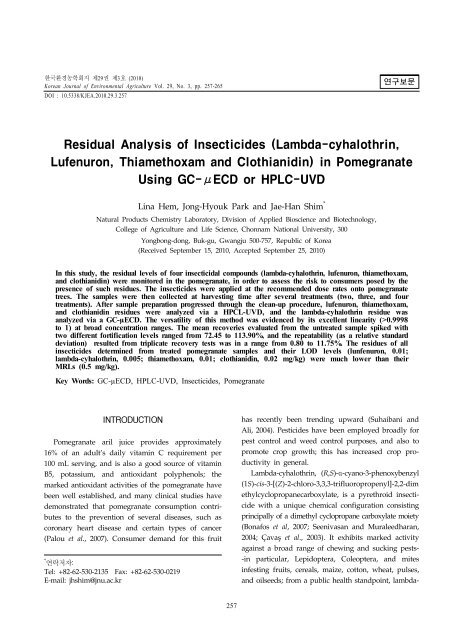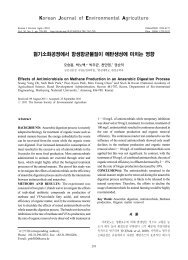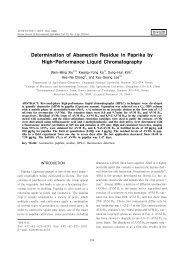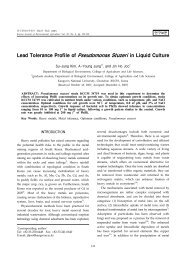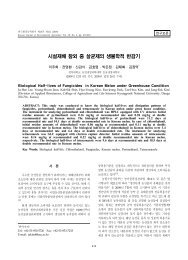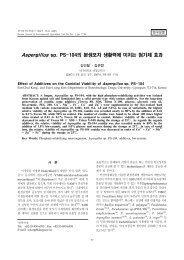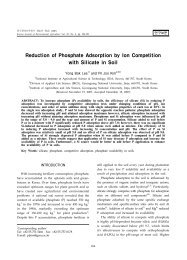06(ìë£)KJEAE-57-(ì¬ì¬í)Residual analysis of insecticides.hwp
06(ìë£)KJEAE-57-(ì¬ì¬í)Residual analysis of insecticides.hwp
06(ìë£)KJEAE-57-(ì¬ì¬í)Residual analysis of insecticides.hwp
You also want an ePaper? Increase the reach of your titles
YUMPU automatically turns print PDFs into web optimized ePapers that Google loves.
한국환경농학회지 제29권 제3호 (2010)<br />
Korean Journal <strong>of</strong> Environmental Agriculture Vol. 29, No. 3, pp. 2<strong>57</strong>-265<br />
DOI : 10.5338/KJEA.2010.29.3.2<strong>57</strong><br />
연구보문<br />
<strong>Residual</strong> Analysis <strong>of</strong> Insecticides (Lambda-cyhalothrin,<br />
Lufenuron, Thiamethoxam and Clothianidin) in Pomegranate<br />
Using GC-μECD or HPLC-UVD<br />
Lina Hem, Jong-Hyouk Park and Jae-Han Shim *<br />
Natural Products Chemistry Laboratory, Division <strong>of</strong> Applied Bioscience and Biotechnology,<br />
College <strong>of</strong> Agriculture and Life Science, Chonnam National University, 300<br />
Yongbong-dong, Buk-gu, Gwangju 500-7<strong>57</strong>, Republic <strong>of</strong> Korea<br />
(Received September 15, 2010, Accepted September 25, 2010)<br />
In this study, the residual levels <strong>of</strong> four insecticidal compounds (lambda-cyhalothrin, lufenuron, thiamethoxam,<br />
and clothianidin) were monitored in the pomegranate, in order to assess the risk to consumers posed by the<br />
presence <strong>of</strong> such residues. The <strong>insecticides</strong> were applied at the recommended dose rates onto pomegranate<br />
trees. The samples were then collected at harvesting time after several treatments (two, three, and four<br />
treatments). After sample preparation progressed through the clean-up procedure, lufenuron, thiamethoxam,<br />
and clothianidin residues were analyzed via a HPCL-UVD, and the lambda-cyhalothrin residue was<br />
analyzed via a GC-µECD. The versatility <strong>of</strong> this method was evidenced by its excellent linearity (>0.9998<br />
to 1) at broad concentration ranges. The mean recoveries evaluated from the untreated sample spiked with<br />
two different fortification levels ranged from 72.45 to 113.90%, and the repeatability (as a relative standard<br />
deviation) resulted from triplicate recovery tests was in a range from 0.80 to 11.75%. The residues <strong>of</strong> all<br />
<strong>insecticides</strong> determined from treated pomegranate samples and their LOD levels (lunfenuron, 0.01;<br />
lambda-cyhalothrin, 0.005; thiamethoxam, 0.01; clothianidin, 0.02 mg/kg) were much lower than their<br />
MRLs (0.5 mg/kg).<br />
Key Words: GC-µECD, HPLC-UVD, Insecticides, Pomegranate<br />
INTRODUCTION<br />
Pomegranate aril juice provides approximately<br />
16% <strong>of</strong> an adult’s daily vitamin C requirement per<br />
100 mL serving, and is also a good source <strong>of</strong> vitamin<br />
B5, potassium, and antioxidant polyphenols; the<br />
marked antioxidant activities <strong>of</strong> the pomegranate have<br />
been well established, and many clinical studies have<br />
demonstrated that pomegranate consumption contributes<br />
to the prevention <strong>of</strong> several diseases, such as<br />
coronary heart disease and certain types <strong>of</strong> cancer<br />
(Palou et al., 2007). Consumer demand for this fruit<br />
* 연락저자:<br />
Tel: +82-62-530-2135 Fax: +82-62-530-0219<br />
E-mail: jhshim@jnu.ac.kr<br />
has recently been trending upward (Suhaibani and<br />
Ali, 2004). Pesticides have been employed broadly for<br />
pest control and weed control purposes, and also to<br />
promote crop growth; this has increased crop productivity<br />
in general.<br />
Lambda-cyhalothrin, (R,S)-α-cyano-3-phenoxybenzyl<br />
(1S)-cis-3-[(Z)-2-chloro-3,3,3-trifluoropropenyl]-2,2-dim<br />
ethylcyclopropanecarboxylate, is a pyrethroid insecticide<br />
with a unique chemical configuration consisting<br />
principally <strong>of</strong> a dimethyl cyclopropane carboxylate moiety<br />
(Bonafos et al, 2007; Seenivasan and Muraleedharan,<br />
2004; Çavaş et al., 2003). It exhibits marked activity<br />
against a broad range <strong>of</strong> chewing and sucking pests-<br />
-in particular, Lepidoptera, Coleoptera, and mites<br />
infesting fruits, cereals, maize, cotton, wheat, pulses,<br />
and oilseeds; from a public health standpoint, lambda-<br />
2<strong>57</strong>
258<br />
Lina Hem, Jong-Hyouk Park and Jae-Han Shim<br />
cyhalothrin also functions effectively as a vector<br />
control agent.<br />
Lufenuron, (RS)-1-[2,5-dichloro-4-(1,1,2,3,3,3-hexafluoropropoxy)phenyl]-3-(2,6-difluorobenzoyl)<br />
urea, is a<br />
benzoylphenylurean (BPU)-class insecticide, which<br />
functions as a chitin synthesis inhibitor (CSI). Doses<br />
<strong>of</strong> lufenuron higher than that recommended for<br />
anti-flea treatment have also proven quite effective in<br />
the treatment <strong>of</strong> dermatomycosis in dogs and cats<br />
(Ahrie et al., 2008; Khay et al., 2008). The compound<br />
appears to be minimally toxic to mammals, since its<br />
activity is highly specific to immature insects at the<br />
molting stage.<br />
Thiamethoxam, 3-[(2-chloro-5-thiazoly)methyl] tetrahydro-5-methyl-N-nitro-4H-1,3,5-oxadiazin-4-imine,<br />
has been newly introduced to the American market<br />
in the past few years and has been approved for use<br />
as a soil, foliar, and seed treatment agent for the<br />
control <strong>of</strong> aphids, whiteflies, and certain beetles, among<br />
others(Campbell et al., 2005; Pandey et al., 2009;<br />
Rancan et al., 20<strong>06</strong>). It is applied during the growing<br />
season in different vegetable crops in India to control<br />
insects and fungal diseases (Singh et al., 2004).<br />
Intensive pesticide use has resulted in contaminations<br />
<strong>of</strong> agricultural products, as well as soil and water.<br />
Pesticide residue <strong>analysis</strong> is essential to address rising<br />
consumer concerns regarding possible contamination<br />
issues. Cyhalothrin has been investigated in this<br />
regard primarily via HPLC methods, but a few<br />
studies using a HPLC-MS have also been performed<br />
recently (Seccia et al., 2008). Some authors’ studies have<br />
dealt with the determination <strong>of</strong> thiamethoxam in<br />
various real samples using different methods; the<br />
LC-MS technique was employed by Obana et al.<br />
(Rancan et al., 20<strong>06</strong>; Pandey et al., 2009; Campbell et<br />
al., 2005; González et al., 2008). Five benzoylureas, including<br />
lufenuron in ground water samples and Chinese<br />
Cabbage, were previously evaluated using HPLC<br />
with different detectors—fluorescence (Garía et al., 20<strong>06</strong>)<br />
and ultraviolet detection as previously described by<br />
Gamon et al. (1998) (Khay et al., 2008). Lambda-cyhalothrin<br />
is mainly detected and analyzed via Gas Chromatography,<br />
but there have also been some research<br />
determinations <strong>of</strong> lambda-cyhalothrin in various samples<br />
using GC-ECD (Seenivasan and Muraleedharan, 2009;<br />
Bouldin et al., 20<strong>06</strong>).<br />
The principal objective <strong>of</strong> this study was to develop<br />
and carry out a routinizable monitoring <strong>of</strong> the residue<br />
levels <strong>of</strong> lambda-cyhalothrin, lufenuron, thiamethoxam,<br />
and clothianidin in the pomegranate.<br />
MATERIALS AND METHODS<br />
Chemicals<br />
Pesticides (lambda-cyhalothrin, lufenuron, thiamethoxam<br />
and clothianidin), all at above 98% purity, were provided<br />
by the Society <strong>of</strong> Pesticide Industries, Republic<br />
<strong>of</strong> Korea.<br />
All reagents and solvents employed herein were <strong>of</strong><br />
analytical-grade or HPLC-grade. Organic solvents were<br />
purchased from Baker NJ (USA), and sodium sulfate<br />
(anhydrous) and sodium chloride were supplied by<br />
Junsei Chemical Co., Ltd (Japan). The silica gel used<br />
for column chromatography cleanup was purchased<br />
from Sigma-Aldrich (USA). Solid phase extraction (SPE;<br />
florisil) cartridge was purchased from phenomenex<br />
(USA).<br />
Sample preparation<br />
Lambda-cyhalothrin, lufenuron, and thiamethoxam,<br />
including its metabolite clothianidin were extracted<br />
individually from pomegranate samples. Exactly 20 g<br />
<strong>of</strong> samples were homogenized with 100 mL <strong>of</strong><br />
methanol-water (50:50, v/v), methanol, or acetone,<br />
respectively, at 1200 rpm for 5 min (WiselMix TM HG-150;<br />
Daehan Scientific, Korea). The homogenates were<br />
then filtered through Whatman filter paper (No. 6)<br />
(Whatman International Ltd, England) topped with<br />
Celite 545 (Daejun Chemicals and Materials Co., Ltd.<br />
Korea) in a porcelain Büchner funnel, and subsequently<br />
washed with the same extraction solvent. The filtrates<br />
for lambda-cyhalothrin and lufenuron were partitioned<br />
with 100 mL dichloromethane and n-hexane, respectively;<br />
whereas the filtrates for thiamethoxam and its<br />
metabolite clothianidin were filled up to a volume <strong>of</strong><br />
200 mL and a 50 mL sample was subjected to<br />
portioning with 100 mL <strong>of</strong> n-hexane. Partitioning was<br />
enhanced by salting-out with 50 mL saturated NaCl.<br />
The partitioned organic layers were then dehydrated<br />
through sodium sulfate (anhydrous) and evaporated<br />
to dryness in a rotary vacuum evaporator (Büchi<br />
Rotavapor R0114, Switzerland) at 40℃. The residues<br />
for lambda-cyhalothrin and lufenuron were dissolved<br />
in 4 mL n-hexane and that for thiamethoxam and
Lambda-Cyhalothrin, Lufenuron, Thiamethoxam and Clothianidin Residues in Pomegranate 259<br />
clothianidin in 5 mL dichloromethane for cleanup.<br />
Clean-up for lambda-cyhalothrin and lufenuron<br />
was conducted using open preparative chromatographic<br />
columns packed with 5 g silica gel and 2 g sodium<br />
sulfate anhydrous (Na 2SO 4) placed atop the columns.<br />
The columns were then activated with 30 mL<br />
n-hexane followed by sample extract loading, after<br />
which the analytes were eluted with the appropriate<br />
solvents. Lambda-cyhalothrin was eluted with 50 mL<br />
acetone-n-hexane (10:90, v/v), while lufenuron was<br />
eluted with 50 mL acetone-n-hexane (15:85, v/v) after<br />
continuous washing with 50 mL n-hexane-acetone<br />
(95:5, v/v) and 50 mL n-hexane-acetone (90:10, v/v).<br />
The eluates were evaporated in vacuo at 40℃ and<br />
then lambda-cyhalothrin was re-dissolved in 2 mL<br />
n-hexane and lufenuron in n-hexane-propanol-methanol<br />
(90:5:5, v/v), lambda-cyhalothrin and lufenuron were<br />
analyzed via GC-µECD and HPLC-UVD, respectively.<br />
Thiamethoxam and clothianidin were purified using<br />
SPE cartridges (florisil 1000 g/6 mL), conditioned<br />
with 5 mL dichloromethane. Sample extracts were<br />
loaded onto the cartridges. The samples were washed<br />
with 10 mL dichloromethane-acetone (96:4, v/v) and<br />
eluted with 25 mL dichloromethane-acetone (55:45,<br />
v/v). The eluates were evaporated in vacuo at 30℃<br />
and re-dissolved in 2 mL methanol-water (50:50,<br />
v/v), and then analyzed via HPLC/UVD.<br />
Method validation<br />
Stock solutions at 100 µg/mL <strong>of</strong> lambda-cyhalothrin,<br />
lufenuron, thiamethoxam, and clothianidin were prepared<br />
in acetone, respectively. Working solutions <strong>of</strong><br />
the analytes were prepared with an adequate solvent<br />
at different six concentrations as follows; 0.025, 0.05,<br />
0.1, 0.25, 0.5, and 1 µg/mL in n-hexane for thiamethoxam;<br />
0.1, 0.5, 1, 2, 4, and 5 µg/mL in n-hexane-propanolmethanol<br />
(90:5:5, v/v/v) for lufenuron; 0.025, 0.05,<br />
0.1, 0.5, 1, and 2 µg/mL for thiamethoxam and 0.05,<br />
0.1, 0.2, 1, 2, and 4 µg/mL for clothianidin in<br />
methanol-water (50:50, v/v), respectively. All stock<br />
and working solutions were stored at -24℃ during<br />
study. Calibration curves were created by the peak<br />
area versus the concentration <strong>of</strong> the analytes’ working<br />
solutions.<br />
To validate the analytical method, recovery tests<br />
were examined by spiking working solutions into<br />
blank samples at different two concentrations in triplicate.<br />
The spiked levels were 0.05 and 0.2 mg/kg for<br />
lambda-cyhalothrin, 0.2 and 0.4 mg/kg for lufenuron,<br />
0.1 and 0.5 mg/kg for thiamethoxam, and 0.2 and 1<br />
mg/kg for clothianidin.<br />
Limits <strong>of</strong> detection (LODs) <strong>of</strong> the analytes were<br />
assessed with a signal-to-noise ratio (S/N ratio). Appropriate<br />
concentrations prepared in blank extracts were<br />
detected by their own analytical instruments, individually,<br />
and every peak height <strong>of</strong> the analytes was<br />
compared with the blank signals.<br />
CONDITIONS OF ANALYTICAL INSTRUMENTS<br />
GC-μECD<br />
Lambda-cyhalothrin <strong>analysis</strong> was conducted using<br />
an Agilent Technologies 7890 A GC System (USA)<br />
consisting <strong>of</strong> a model 7683B autoinjector and an<br />
µ-electron capture detector. Chromatographic separation<br />
was conducted using an HP-5 (50 m × 0.25 mm, 0.25<br />
µm film thickness) column. The oven temperature was<br />
held at 120℃ for 5 min and then increased to 270℃<br />
at a rate <strong>of</strong> 5℃/min for 5 min. The injection port and<br />
detector temperatures were maintained at 250℃ and<br />
280℃, respectively. The injection volume was 2 µL,<br />
and the column was flowed with nitrogen gas at 1<br />
mL/min.<br />
HPLC-UVD<br />
Lufenuron <strong>analysis</strong> was conducted using a Kontron<br />
HPLC system (Italy) consisting <strong>of</strong> a 355 UV-detector<br />
and a 322 pump. Chromatographic separation was<br />
conducted using a Waters Spherisorb® 5 µL NH 2, 4.6<br />
× 250 mm. The mobile phase was a mixture <strong>of</strong><br />
n-hexane-propanol-methanol (90:5:5, v/v) and 20 µL<br />
<strong>of</strong> sample was injected into an HPLC column. Lufenuron<br />
was detected at a wavelength <strong>of</strong> 250 nm, and the<br />
detected time <strong>of</strong> lufenuron was 12.92 min.<br />
Analysis <strong>of</strong> thiamethoxam and clothianidin was<br />
conducted using the Shimadzu liquid chromatography<br />
system equipped with a SCL-10AVP system controller,<br />
LC-6AD pumps, and a SPD-10AVP UV-vis detector<br />
(Shimadzu, Kyoto, Japan). An Aqua C18 200Å (4.6×250<br />
mm, 5.0 µm, Phenomenex, USA) was employed as an<br />
analytical column for the target compound. The mobile<br />
phase was a mixture <strong>of</strong> methanol-water (30:70, v/v),<br />
and the flow rate was 0.6 mL/min. 20 µL <strong>of</strong> sample<br />
was injected onto the HPLC column. Thiamethoxam
260<br />
Lina Hem, Jong-Hyouk Park and Jae-Han Shim<br />
and clothianidin were detected at a wavelength <strong>of</strong><br />
230 nm; the detection time <strong>of</strong> thiamethoxam was<br />
10.60 min, and 16.<strong>57</strong> min for clothianidin.<br />
RESULTS AND DISCUSSION<br />
Extraction<br />
In this study, pesticides were extracted from<br />
pomegranate fruits via liquid-liquid extraction. The<br />
whole procedures were simply divided into the<br />
following steps: extraction with a polar solvent, liquidliquid<br />
partition with a polar solvent, and cleanup<br />
with an open preparative chromatographic column<br />
packed with a polar sorbent or an SPE cartridge. A<br />
few methods have been previously developed for the<br />
determination <strong>of</strong> lufenuron residues in various matrices,<br />
including fruit, vegetables, blood, and groundwater.<br />
These studies have generally employed liquid chromatography<br />
with mass spectrometric, fluorescence, or diodearray<br />
detection, and the procedures have generally<br />
been derived from solvent partitioning and solid<br />
phase extraction protocols (Brito et al., 2002; Khay et<br />
al., 2008). The n-hexane partition cleanup procedure<br />
appears to effectively remove interfering co-extractives<br />
for HPLC <strong>analysis</strong> (Singh et al., 2004). The n-hexane<br />
partition procedure for the <strong>analysis</strong> <strong>of</strong> the insecticide<br />
lambda-cyhalothrin was previously developed and<br />
described by Seenivasan et al. (2009) (Seenivasan and<br />
Muraleedharan, 2009), in a study <strong>of</strong> the residues <strong>of</strong><br />
lambda-cyhalothrin in tea, and Singh et al. (2004)<br />
(Singh et al., 2004) used a similar method to analyze<br />
thiamethoxam residues in fresh and cooked vegetable<br />
samples. The sample preparation method employed<br />
in this study also resulted in reliable results, which<br />
were demonstrated in the validation results.<br />
Linearity<br />
Lambda-cyhalothrin, lufenuron, thiamethoxam and<br />
clothianidin evidenced good linearity at the different<br />
concentrations employed. The linear equations were<br />
as follows: Y=21565.02x + 650.47; Y=61.009x + 3.6892;<br />
Y=104382.92x - 628.87; and Y=62164.83x - 374.25, respectively.<br />
The correlation coefficients (r 2 ) ranged from<br />
0.9998 to 1.<br />
Recovery<br />
The analytical methods were validated for the<br />
black pomegranate prior to actual <strong>analysis</strong>. In an<br />
effort to validate the analytical method, the recovery<br />
percentage was established via the fortification <strong>of</strong><br />
standard solutions <strong>of</strong> lambda-cyhalothrin, lufenuron,<br />
thiamethoxam, and clothianidin. The achieved recoveries<br />
ranged from 73.61% to 108.89% with a standard<br />
deviation <strong>of</strong> ±11.45%, which indicated that the mean<br />
recovery should be within a range <strong>of</strong> 70-110% in<br />
order to sufficiently validate the quantitative methods.<br />
These results were also fitted in accordance with the<br />
relevant international guidelines (SANCO, 2004).<br />
Limit <strong>of</strong> detection (LOD)<br />
The LODs were calculated considering a value 3<br />
times the background noise obtained for blank samples,<br />
which also included the instrument noise. The calculated<br />
LODs were 0.005 (lambda-cyhalothrin), 0.01<br />
(lufenuron), 0.01 (thiamethoxam), and 0.02 mg/kg<br />
(clothianidin) (Table 1). All limits were substantially<br />
lower than the MRLs <strong>of</strong> 0.5 mg/kg established by the<br />
Korea Food and Drug Administration (KFDA, 2005).<br />
Stability <strong>of</strong> the analytes<br />
The residue analyses <strong>of</strong> the field samples were<br />
conducted subsequent to the completion <strong>of</strong> the experimental<br />
procedures. As the determination <strong>of</strong> lambdacyhalothrin,<br />
lufenuron, thiamethoxam, and clothianidin<br />
residues could be delayed as the result <strong>of</strong> unforeseen<br />
systematic errors and/or poor preliminary experimental<br />
results, the actual residues could be altered by<br />
chemical or metabolic reactions with sample matrices<br />
during storage. Therefore, it is necessary that the<br />
stability <strong>of</strong> the analytes be evaluated in samples stored<br />
Table 1. Calibration curve and linearity <strong>of</strong> the analytes<br />
Pesticides Concentration range (mg/kg) Equation r 2 value<br />
Lambda-cyhalothrin 0.025 - 6 Y=21565.02x + 650.47 1<br />
Lufenuron 0.1 - 5 Y=61.009x + 3.6892 0.9998<br />
Thiamethoxam 0.025 - 2 Y=104382.92x - 628.87 1<br />
Clothianidin 0.05 - 4 Y=62164.83x - 374.25 1
Lambda-Cyhalothrin, Lufenuron, Thiamethoxam and Clothianidin Residues in Pomegranate 261<br />
Table 2. Validation <strong>of</strong> the analytical method <strong>of</strong> compounds in pomegranate<br />
Insecticides<br />
Concentration<br />
(mg/kg)<br />
Recovery (%)<br />
I II III<br />
Average<br />
(%)<br />
SD<br />
(%)<br />
LOD<br />
(mg/kg)<br />
Lambda-cyhalotherin<br />
Lufenuron<br />
Thiamethoxam<br />
Clothianidin<br />
0.05 85.41 91.04 90.00 82.70 5.75 0.005<br />
0.2 95.46 81.59 85.97 87.67 7.09<br />
0.2 95.75 101.59 88.52 95.15 6.35<br />
0.4 113.9 105.14 91.19 103.41 11.45<br />
0.1 86.64 90.49 84.34 87.15 3.11<br />
0.5 72.45 74.50 73.89 73.61 1.05<br />
0.2 87.37 90.89 110.40 108.89 3.53<br />
1 87.37 90.89 88.72 88.99 1.77<br />
0.01<br />
0.01<br />
0.02<br />
Table 3. Storage stability <strong>of</strong> the analytes<br />
Pesticides<br />
Spiked<br />
Recovery (%)<br />
concentration I II III<br />
Average (%)<br />
Lambda-cyhalothrin 5 93.97 98.42 80.62 91.03 ± 9.27<br />
Lufenuron 0.4 105.05 85.61 1<strong>06</strong>.27 99.18 ± 11.75<br />
Thiamethoxam 0.5 71.<strong>06</strong> 69.45 70.93 70.48 ± 0.89<br />
Clothianidin 1 85.04 90.16 84.00 86.40 ± 3.30<br />
Table 4. Residue levels <strong>of</strong> the analytes in field-incurred pomegranates<br />
Spraying times<br />
Lambda-cyhalothrin<br />
(mg/kg)<br />
Lufenuron<br />
(mg/kg)<br />
Thiamethoxama<br />
(mg/kg)<br />
Control
262<br />
Lina Hem, Jong-Hyouk Park and Jae-Han Shim<br />
A<br />
B<br />
C<br />
D<br />
Fig. 1. Typical GC-µECD chromatograms <strong>of</strong> lambda-cyhalothrin; control pomegranate (A), standard at 1 µg/ mL (B),<br />
recovery sample at 0.2 mg/ kg (C), and treated sample 4 times (D).
Lambda-Cyhalothrin, Lufenuron, Thiamethoxam and Clothianidin Residues in Pomegranate 263<br />
A<br />
B<br />
C<br />
D<br />
Fig. 2. Typical HPLC chromatograms <strong>of</strong> lufenuron; control pomegranate (A), standard at 4 µg/ mL (B), recovery sample<br />
at 0.4 mg/ kg (C), and treated sample 2 times (D).
264<br />
Lina Hem, Jong-Hyouk Park and Jae-Han Shim<br />
A<br />
B<br />
C<br />
D<br />
Fig. 3. Typical HPLC chromatograms <strong>of</strong> thiamethoxam and clothianidin; control pomegranate (A), standard<br />
thiamethoxam at 1 µg/ mL and clothianidin at 2 µg/ mL (B), recovery sample thiamethoxam at 0.5 mg/ kg and<br />
clothianidin at 1 mg/ kg (C), and treated sample 2 times (D).
Lambda-Cyhalothrin, Lufenuron, Thiamethoxam and Clothianidin Residues in Pomegranate 265<br />
ACKNOWLEDGEMENT<br />
This work was supported by the National Agricultural<br />
Products Quality Management Services (NAQS),<br />
Gwangju, Republic <strong>of</strong> Korea.<br />
REFERENCES<br />
Ahrie, K.C., Arora, M.S., Mukherjee, S.N., 2008.<br />
Development and application <strong>of</strong> a method for<br />
<strong>analysis</strong> <strong>of</strong> lufenuron in wheat flour by gas chromatography-mass<br />
spectrometry and confirmation<br />
<strong>of</strong> bio-efficacy against Tribolium castaneum (Herbst)<br />
(Coleoptera: Tenebrionidae), J. Chromatogr. B 861,<br />
16-21.<br />
Al-suhaibani, A.M., Ali, A.G., 2004. Susceptibility <strong>of</strong><br />
some pomegranate fruit cultivars to myelois ceratonia<br />
zeller (Lepidoptera:phycitidae) with some notes<br />
on its population fluctuation and control measures,<br />
Minia J. <strong>of</strong> Agric. Res. & Develop. 24, 335-346.<br />
Bonafos, R., Serrano, E., Auger, P., Kreiter, S., 2007.<br />
Resistance to deltamethrin, lambda-cyholathrin<br />
and chlorpyriphos-ethyl in some populations <strong>of</strong><br />
Typhlodromus pyri Scheuten and Amblyseius andersoni<br />
(Chant) (Acari:Phytoseiidae) from vineyards in<br />
the south-west <strong>of</strong> France, J. Crop Pro. 26, 169-172.<br />
Bouldin, J.L., Farris, J.L., Moore, M.T., Smith, Jr.S.,<br />
Cooper, C. M., 20<strong>06</strong>. Hydroponic uptake <strong>of</strong> atrazine<br />
and lambda-cyhalothrin in Juncus effusus and<br />
Ludwigia peploides, Chemosphere 65, 1049–10<strong>57</strong>.<br />
Brito, N.M., Navickiene, S., Polese, L., Jardim, E.F.G.,<br />
Abakerli, R.B., Ribeiro, M.L., 2002. Determination<br />
<strong>of</strong> pesticide residues in coconut water by liquidliquid<br />
extraction and gas chromatography with<br />
electron-capture plus thermionic specific detection<br />
and solid-phase extraction and high-performance<br />
liquid chromatography with ultraviolet detection,<br />
J. Chromatogr. A, 9<strong>57</strong>, 201-209.<br />
Campbell, S., Chen, L., Yu, J., Li, Q.X., 2005. Adsorption<br />
and <strong>analysis</strong> <strong>of</strong> the insecticide Thiamethoxam and<br />
Indoxacarb in Hawaiian Soil, J. Agric. Food Chem.<br />
53, 5373-5376.<br />
Çavaş, T., Gözükara, S.E., 2003. Evaluation <strong>of</strong> the<br />
genotoxic potential <strong>of</strong> lambda-cyhalothrin using<br />
nuclear and nucleolar biomarkers on fish cells,<br />
Mutat. Res. Genet. Toxicol. Environ. Mutagen. 534, 93-99.<br />
Garía, M.D.G., Galera, M.M., Martínez, D.B., Gallego,<br />
J.G., 20<strong>06</strong>. Determination <strong>of</strong> benzoylureas in<br />
ground water samples by fully automated on-line<br />
pre-concentration and liquid chromatography-fluorescence<br />
detection, J. Chromatogr. A, 1103, 271-277.<br />
González, R.R., Frenich, A.G., Vidal, J.L.M., 2008.<br />
Multiresidue method for fast determination <strong>of</strong> pesticides<br />
in fruit juice by ultra performance liquid<br />
chromatography coupled to tandem mass spectrometry,<br />
Talanta 76, 211-225.<br />
Khay, S., Choi, J.-H., Abd El-Aty, A.M., Mamun,<br />
M.I.R., Park, B.-J., Goudah, A., Shin, H.C, Shim,<br />
J.H., 2008. Dissipation Baehavior <strong>of</strong> Lufenuron,<br />
Benzoylphenylurea Isecticide, in/on Chinses Cabbage<br />
Applied by Foliar Spraying Under Greenhouse<br />
Condition, Bull. Environ. Contam. Toxicol. 81, 369-372.<br />
Palou, L., Crisosto, C.H., Garner, D., 2007. Combination<br />
<strong>of</strong> postharvest antifungal chemical treatments<br />
and controlled atmosphere storage to control gray<br />
mold and improve storability <strong>of</strong> ‘Wonderful’<br />
pomegranates, Postharvest Biol. Technol. 43, 133-142.<br />
Rancan, M., Rossi, S., Sabatini, A.G., 20<strong>06</strong>. Determination<br />
<strong>of</strong> Thiamethoxam residues in honeybees by<br />
high performance liquid chromatography with an<br />
electrochemical detector and post-column photochemical<br />
reactor, J. Chromatogr. A, 1123, 60-65.<br />
Pandey, G., Dorrian, S.J., Russell, R.J., Oakeshott, J.G.,<br />
2009. Biotransformation <strong>of</strong> the neonicotinoid<br />
<strong>insecticides</strong> imidacloprid and thiamethoxam by<br />
Pseudomonas sp. 1G, J. Biochem. Biophys. Res. Commun.<br />
380, 710-714.<br />
SANCO, Quality control procedures for pesticides<br />
residue <strong>analysis</strong>. European Commission, Directorate<br />
General Health and Consumer Protection. Document<br />
no. SANCO/10476/2003, February 2004.<br />
Seenivasan, S., Muraleedharan, N.N., 2009. Residues<br />
<strong>of</strong> lambda-cyhalothrin in tea, Food Chem. Toxicol.<br />
47, 502-505.<br />
Seccia, S., Fidente, P., Montesano, D., Morrica, P.,<br />
2008. Determination <strong>of</strong> neonicotinoid <strong>insecticides</strong><br />
in bovine milk samples by solid-phase extraction<br />
clean-up and liquid chromatography with diodearray<br />
detection, J. Chromatogr. A, 1214, 115-120.<br />
Singh, S.B., Foster, G.D., Khan, S.U., 2004. Microwave-assisted<br />
extraction for the simultaneous<br />
determination <strong>of</strong> thiamethoxam, imidacloprid, and<br />
carbndazim residues in fresh and cooked vegetable<br />
sample, J. Agric. Food Chem. 52, 105-109.


